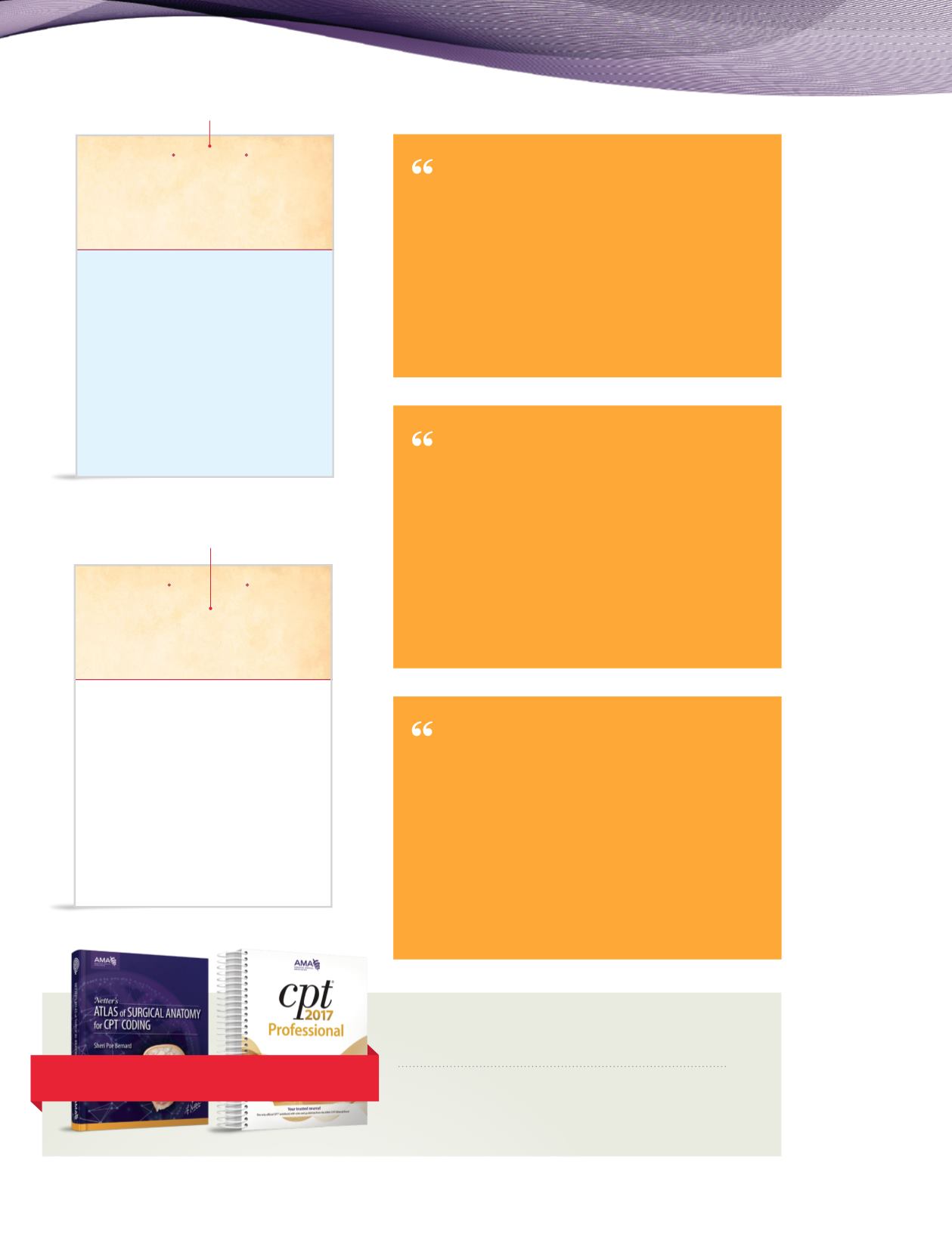
ONLINE
PHONE
(800) 621-8335
FAX
(312) 464-5600
AMERICANMEDICALASSOCIATION
Fall 2016
19
CODINGFORYOURSPECIALTY
CHAPTER 2
Tendons
flow frommuscle and secure to bone.
Cartilage
extends from the surface of abone at a joint to reduce
frictionduringmovement.
Joints flex to varyingdegrees.Fibrous joints are
immobile; cartilaginous jointshave limitedmovement;
and synovial jointshave ahighdegree ofmovement.The
fibrous joints in the skull, eg,provide flexibilityduring
birthbut are immobile in adulthood.Costal cartilages
connect ribsnumbered 8 through10 to the sternum.The
jointbetween the rib and sternumhas limitedmovement,
allowing for expansion of the rib cageduring respiration.
Vertebrae are also connectedby cartilaginous joints.
Synovial joints are themost common joints in the body.
These joints are sealed in a synovialmembrane that
creates lubricating fluid and arewrapped in tough
ligaments
to give the joint strength and support.A bursa
is a fluid-filled sac that functions to reduce friction
between two structures in a synovial joint
Eachmuscle ormuscle grouping is encased in
fascia
,
allowing it tomove independently from surrounding
tissue. Skeletalmuscle contracts in response to electrical
stimuli frommotorneurons of the spinal cord.When a
muscle contracts, its tendonspull on thebone towhich it
is attached, causing bonemovement.Amusclemay be
named based on its attachments, eg, sternocleidomastoid
muscle connects the sternum and clavicle to themastoid
process.Others arenamed based on their location, eg, the
orbicularis oculimuscle is located at the orbit.
Allproceduresusing arthroscopic approach are segregated
in theMusculoskeletalSystem code set, appearing toward
the endof the section.Excluded from theMusculoskeletal
System code set are codesused to reportprocedures
performed on bonemarrow.Theseprocedures are
reportedusing codes from theHemic andLymphatic
Systems code set.
T
hemusculoskeletal system is composedof
muscle,bone, andother connective tissue.An
adultbody containsmore than200bones
that,when articulated, give it structure and
mobility.Bones also function toprotectorgans, eg, the
skullprotects thebrain and the sternumprotects theheart.
Bonesprovide a reservoir for calcium andphosphorus,
essentialminerals for cellular activities throughout the
body.Bones are remodeled in response tophysical stressor
damage (such as exerciseor simply from theweightofour
bodies) and tohormones andother chemicals circulating
in theblood throughout life.Bone remodeling adjusts
bone architecture tomeet changingmechanicalneeds and
helps to repairmicrodamages inbonematrix toprevent the
accumulationofoldbone. It alsoplays an important role
inmaintainingplasma calciumhomeostasis.
Sites on bone are identified by theirpurpose or shape.A
process is a bonyprojection orprominence.There are
several types ofprocesses thathelp form joints.A condyle
is a large and roundedprominence at a joint; a facet is a
flat and smooth bone surface; ahead is the enlarged end
of a bone at a joint; and the ramus is a branch of bone.
Otherprocessesprovide an environment for attachment
ofmuscle or ligament.A crest is anarrow ridge; a
epicondyle is a secondaryprominence above a condyle; a
linea is anarrow ridge; a spinousprocess is apointy or
sharpprominence; a trochanter is an irregularprocess
found only on the femur; a tubercle is a small knobby
process; and a tuberosity is a large knobbyprocess.
Bones accommodate blood vessels andnerves along
depressions or openings.These anatomic sites are also
named according to their function.For example, a fissure
is anarrowpassageway; a fontanel is a space between skull
bones; a foramen is a round opening; a fossa is a shallow
depression; a fovea is a small,deepdepression; a sinus is a
bony tube; and a sulcus is a long andnarrow groove.
Musculoskeletal
System
27
Chapteropeners containanoverviewof theanatomical
system(s) toprovideabasicunderstandingof
pathophysiology thatmayaffect code selection
Aglossaryofprocedural andanatomical terms
that simplifies complex terminology
I lovemy
Netter’sAtlasofSurgicalAnatomy
forCPT®Coding
.
Asavisual learner I can
reviewthepictures, readtheCPT®description,
theCodingAtlasnotesand thefigural
notationsall inoneplace.Havingallof this
information together, allowsme tocode
andauditwithmuchgreaterunderstanding
andconfidence.”
—SimoneTessitore, CPC, COBGC
Tulsa,OK
This resourcehelps thecoderunderstand
the terminologyoftenseen inoperative
reports,which iswell explained throughout.
For thosewithout significantexperience in
aparticularspecialtyorexpertise incoding
ofparticularprocedures, this reference is
invaluable.This isone resource thatbelongs
withinarm’s reach.”
—MichaelM.Miscoe, JD, CPC, CASCC, CUC,
CCPC, CPCO, CPMA
Central City, PA
This is thebook Ihavebeenwaiting for!
Ms.Bernard’sexpertise inanatomyand
pathophysiology iseasilyapparentasshe
dissectseachcodegroupwithclearand
concisedescriptions thatdeepen thecoder’s
ability tounderstand theassignmentof the
codesand theaccuracyofassignmentof the
codes.This text isamust foreverycoder’s
deskasa reference that isbeyondcompare.”
—Carol J. Buck
GrandForks,ND
Purchase
Netter’sAtlasof Surgical Anatomy forCPT®
Coding
alongwith
CPT®2017Professional Edition
.
Item#:OP498217
Price: $199.67
AMAMEMBERPRICE:$163.79
Non-package fullprice: $234.90
adenoma.
Benign epithelial tumor that resembles or arises
in glandular tissue.
adenopathy.
Swelling or enlargement of lymphnodes.
adhesiolysis.
Surgical cutting or stripping out of band(s)
of scar tissue between organs or body surfaces.
adhesions.
Bands or scarsbetween organs orbody surfaces
that cause tension and obstructnormalmovement.
adipose.
Anatomical fat.
adjacent tissue transfer.
Surgical rearrangement ofnearby
healthy tissue around awound, sometimes called a
local flap.
adjuvant.
Supplemental, eg, a therapy in addition to a
primary therapy.
adnexa,adnexal.
Anatomical structures that are in close
proximity to another structure.
adrenalectomy.
Surgical excision of all orpart of the
adrenal gland, also called suprarenal gland.
adrenaline.
Neurohormoneproduced inhigh-stress
situations, also called epinephrine.
advancement.
Surgical repositioning to amoredistalpoint.
afferent.
Flowing toward the center, eg, the brain or
lymphnode; opposite of efferent.
afterloading.
Practice of filling after surgical insertion, eg,
with brachytherapydevices that canbe surgicallyplaced,
then injectedwith a radioactive substance afterward.
albumin.
Simpleprotein found throughout biological
tissues and fluids.
abdominalcavity.
Anatomic site bounded by the
diaphragm, abdominalwalls, andpelvis.
abduction.
Movement of a limb away from the body;
opposite of adduction.
aberrant.
Abnormal, or varying from standard.
ablation.
Surgical removal ordestruction of the function
of a bodypart.
abscess.
Localized inflammationwithin a tissue or organ
that forms a cavity containingpus.
acetabuloplasty.
Surgical reconstruction of the cup-shaped
socket of thehip joint.
achalasia.
Disorder of esophagealmusclemovement; an
impediment to swallowing.
acid reflux.
Backflow of stomach acid into the esophagus.
acousticnerve.
Division of the eighth cranialnerve
(CNVIII, vestibulocochlearnerve) that transmits sound
sensations to the brain.
acousticneuroma.
Tumor,usually benign, arising from the
eighth cranialnerve (CNVIII).
acquired.
Occurring after birth.
acrochordon.
Cutaneous skin tag,usually benign.
acromionectomy.
Surgical excision of all orpart of thebony
process of the shoulder blade (scapula).
acromioplasty.
Surgical reconstruction of the bonyprocess
of the shoulder blade (scapula).
acute.
Of sudden onset andusually of brief course.
adduction.
Movement of a limb toward the body; opposite
of abduction.
Glossary
APPENDIX A
459


